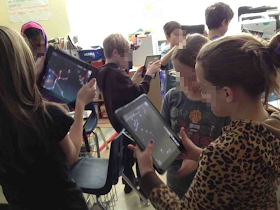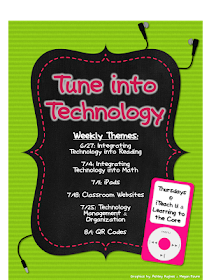Usually when I talk to people about the fact that I teach in a 1:1 iPad classroom, they think that's awesome. But now and again, I'll run into someone who thinks handing a kid an iPad in school is an atrocity, and I feel like I have to defend the work that I'm passionate about. This happened to me recently at a social event when my attempts at small talk quickly turned into a debate about what we're "doing to kids today." The naysayers certainly exist, and this particular encounter made me pause to think about why I feel so strongly about this topic.
Here are some of the reasons I feel it's in the best interests of both students and teachers to maximize the use of classroom technology.
 |
| My students explore constellations on their iPads. |
1. It teaches real-world problem solving skills.
Being good at technology is largely a result of being willing to experiment and fail. I wasn't born knowing everything there is to know about iPads or Evernote or Edmodo -- I've learned by trying different things and seeing what worked and what didn't. When I can't figure it out on my own, I talk to others or look for the information I need online. Now I get to see these skills in my students. Whenever they need to troubleshoot something, they work together to find a solution. They don't give up or think it's impossible. In this high-tech world, these skills are going to be incredibly valuable.
2. It facilitates better communication between home and school.
If parents want to know what we're doing in class each day, they can find all of our homework and activities on our class website. If they want to monitor grades or see what assignments are missing, they can look on
Edmodo. If they want to know what their child's behavior was like at school today, they can look on
ClassDojo and get a report. If they want to know what their child sounded like reading a 4th grade leveled text at the beginning of the year compared to now at the end of the year, I can pull up the child's audio recordings on
Evernote. Technology makes it easier for parents to know what's happening in school, and I'm happy about that.
3. It makes students better writers.
Without question, writing skills are incredibly important. When I think back on all of the essays I had to write in high school and college or the cover letters I wrote to get opportunities I have today, I know that my ability to write mattered. Technology makes students better writers for a variety of reasons:
- It makes them more open to revising and publishing their work when they don't have to handwrite the whole paper over again.
- It teaches them typing skills that will make them more efficient at writing and therefore able to write more.
- It gives me more opportunities to give them feedback about their writing because I can easily collect samples at various points. I can have them turn in a copy of a draft wherever they're at without interrupting their work because I don't have to collect a notebook.
4. It keeps kids engaged.
I used to have students write book reports. Now I have them write book blogs on
KidBlog and make book trailers using
iMovie. It's basically the same assignment, but now students are motivated and engaged to complete it. They have an audience of their peers that makes their work more authentic, and it's something that can't be easily replicated without technology. The effort and outcomes my students experience because of technology is something that should be encouraged.
I think a lot of the criticisms of technology assume that students are being passive consumers of it -- watching videos or playing video games all of the time. Without question, technology could be used as a high-tech babysitter, but that's not how it's being used in my classroom at all. When my students use their iPads, they are active and interactive, and they're expressing their creativity in so many ways now. They're making movies, writing stories and articles, becoming budding photographers, and interacting with the world and each other in new and exciting ways. They're still collaborating and developing the interactive social skills necessary to be productive citizens of society.
6. It keeps everyone more organized.
I can't begin to describe how many minutes I've lost over the last 6 years because students couldn't find a paper or a notebook. Then once it was turned in, I'd have to shuffle through piles of nearly 30 to find what I was looking for. Add to that the fact that students work at different rates and finish tasks at different times, and you have the potential for an organizational nightmare.
I'm a pretty organized person, but without any hesitation I can say that technology has made my students and me substantially more organized. Everything we need can be found on an iPad or a computer. There isn't instructional time lost finding materials or planning time lost figuring out where I filed that lesson idea or who is missing work. It's all in one spot.
7. It allows me to give better feedback.
My students recently took a multiple choice test on
Edmodo. I'd entered the correct answers before giving the test, so when I went to look at the results, it was already graded for me. Rather than spending time rifling through a pile of papers to mark answers right or wrong, I was able to type specific feedback to the students. For example, when several students missed question #6, I typed 2 sentences explaining the problem with the answer choice they selected and why the other choice was better. With the help of copy and paste, I was able to give that feedback to all applicable students in less than 5 minutes. How often do you think I could accomplish that in a world where I had to handwrite the comment 15+ times? It wouldn't happen. I wish it could, but it's not feasible.
8. It gives me more information so I can help students.
I routinely ask my students to solve math problems and explain their thinking. Sometimes they have to explain it in words and sentences, but other times I let them use their iPads to make short (30-60 second) videos narrating their solutions and the steps they took. Similarly, when I do reading assessments with students, I can use my iPad to record the student's voice as the student reads. This creates an artifact that I can listen to, share with parents or RTI committees, and analyze in a way that wouldn't be possible absent technology. It's some of the best evidence of a student's ability, and it helps me identify strengths and weaknesses so I can give students the support they need.
9. It makes me more efficient.
Anyone who's a teacher can attest that this job sometimes borders on impossible. Teachers take on so many roles and have so many responsibilities that the stress can be overwhelming. I think that's a major factor in why so many great teachers leave this profession within the first few years and why many capable individuals are deterred from entering the field. In my experience, technology has made this all more bearable. I don't have to waste time shuffling through paper or hunting for files anymore. I don't have to haul carts -- literally carts -- of student work and planning materials home anymore. I can find exactly what I need wherever I'm at because everything is electronic. It's made me much more productive and efficient, and everyone benefits as a result.
10. It's appropriate for the world we live in.
I know a lot of people lament the fact that we've moved into an age of technology. I'm not one of them, but even if I were, I recognize that there's no going back now. I'd rather introduce students to technology in safe, structured ways where I can guide them through the perils and pitfalls than leave them to struggle on their own. I also like that I can show them how to make technology work effectively for them. I'm facilitating students to be productive, creative, and responsible users of technology, and I'm not confident they'd all get there on their own.
It's not technology that's an issue -- it's how the technology is being used. I'm certain that the ways my fourth graders use their iPads will make them better informed, more capable citizens down the road. Is it the only way to teach them? Absolutely not, but the advantages of using technology in the classroom far outweigh any disadvantages the devices bring.
What are the arguments for or against using technology in the classroom that you've heard? I'd love to hear your thoughts in the comments.





































